On few urban tram systems freight trams were operated. There were urban systems having transport of a single type of goods over a single route, but Porto was exceptional with significant transport of many different kinds of freight with sidings for (un)loading scattered over most of the network. This page gives an overview, although not complete as the sources are limited.
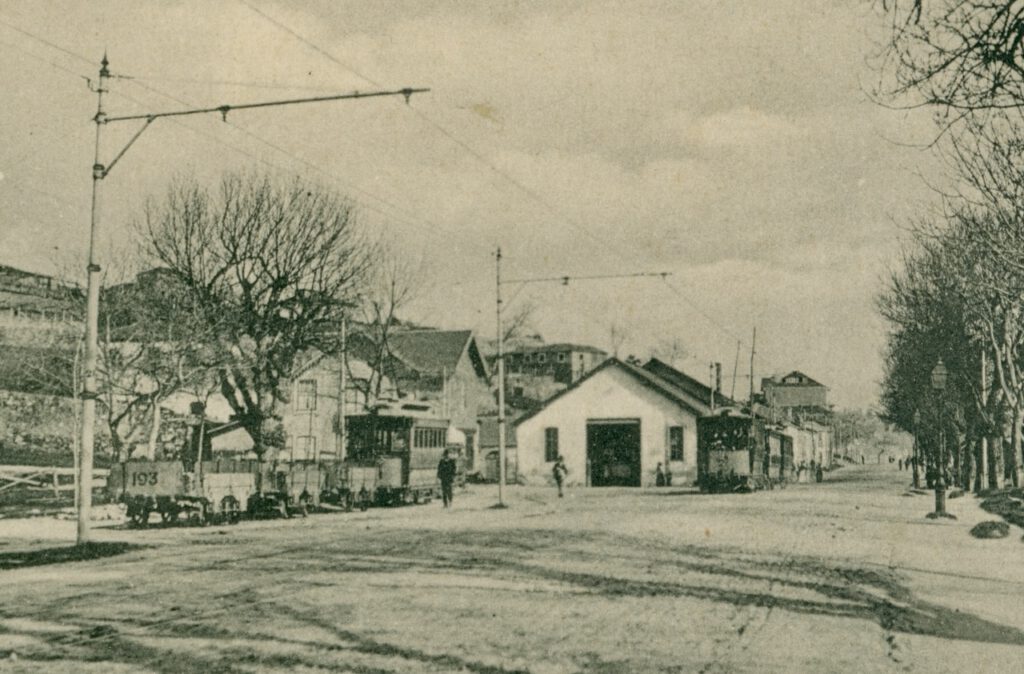
Mule freight trams
Both first Porto tram companies, the CCA and the CCFP, already carried freight with mule trams. Little is known about the freight operations of both companies, but when the two fleets were combined early 1893, the CCFP had 18 tramcars for freight and luggage and the CCA had six. In 1886 the CCA transported 10,839 ton material to be used for constructing the Porto de Leixões (harbour of Leixões). With mule freight trams this must have been roughly 2700 trips to complete the whole transport. This transport was between a short branch made in 1884 to the riverside near the Ouro depot and the Prado station of the narrow gauge railway that was also built in 1884 between the quarry of São Gens and the construction sites of the moles for the Leixões harbour. Both the CCA and the CCFP had a siding at the Prado station. Likely this transport included the parts of both Titan cranes that were ordered in 1886 from Fives-Lille. Both cranes were assembled the same year, at Senhor do Padrão the Titan crane for the southern mole and at Castelo da Leça the Titan crane for the northern mole.
The last freight transport with mule trams was of fish between the Boavista-PPF railway station and the market at Cordoaria. It was ended on 15 October 1904 because the CCFP didn’t have mules available anymore.
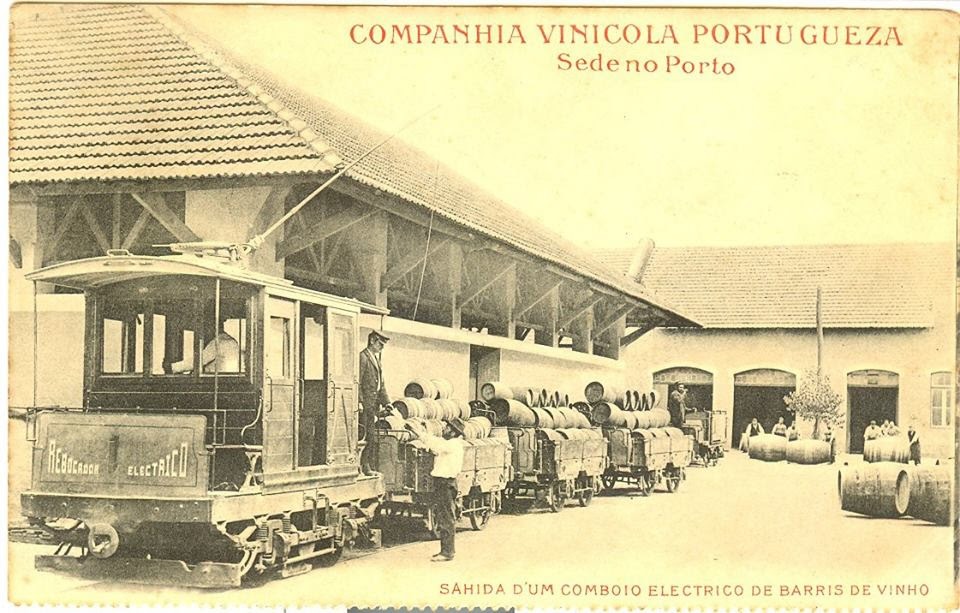
Electric freight trams
Soon after the electrification of the Marginal also electric freight trams were introduced.
In 1899 the CCFP put in service two electric “rebocadors”, motorcars designed to tow freight trailers. A photo shows one of them with a train of open freight cars on the site of Vinicola in Matosinhos. Apparently they had only one controller with the motorman standing in the centre of the cabin. That meant poor visibility and it seems both were soon reconstructed getting controllers on both platforms.
In 1903 three more electric freight trams were constructed. They were indicated as “wagons eléctricos” and got the numbers 83-85. In 1904 no.86 was added to the fleet. According to the annual reports of 1905-07 there were 3 “wagons eléctricos cobertos” (closed wagons) and 2 “wagons eléctricos abertos” (open wagons). Likely one of the first electric freight cars had only a short life.
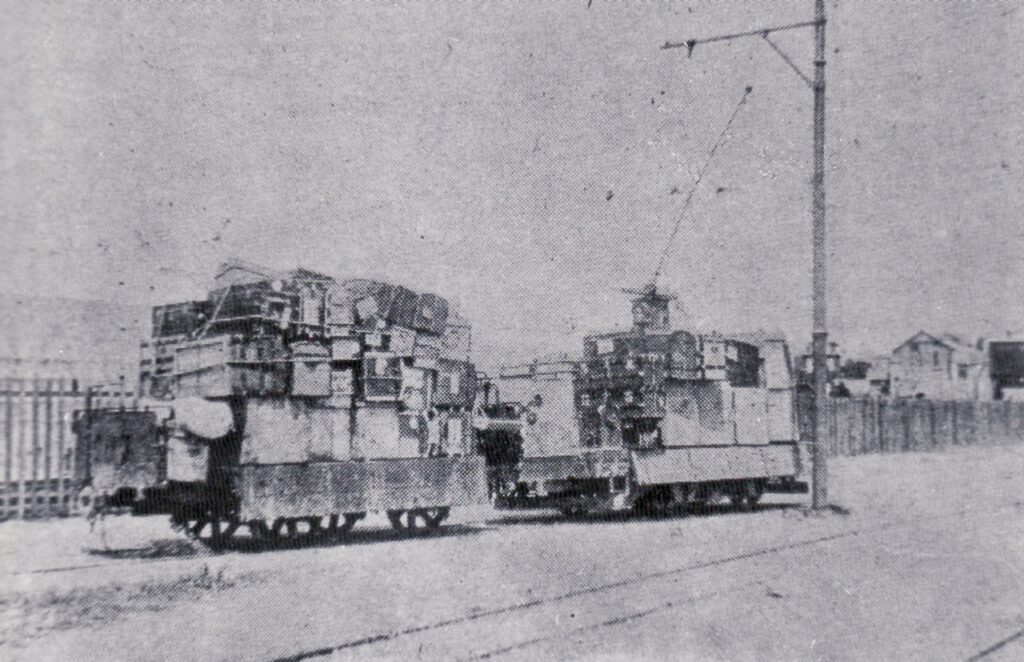
In 1899 and 1901 the local company A Constructora built a total of nineteen open freight trailers. Together with the old mule trams for freight the fleet of freight trailers reached a maximum of about 40.
The local firm Companhia Alliança built in 1910 two closed freight trams on Brill 21E trucks and with GE80 motors. At that time there existed already two others with unknown origins. They might have been reconstructions of the two rebocadores of 1899. It’s unknown if the three closed freight trams that were used by the STCP as works cars were the same as three of these four closed freight cars from the early years, or that it were later constructions of the workshops as replacements of the older cars. The type was known as vagão (plural vagões). One of these vagões became break-down assistance tram no.76 and is still available.
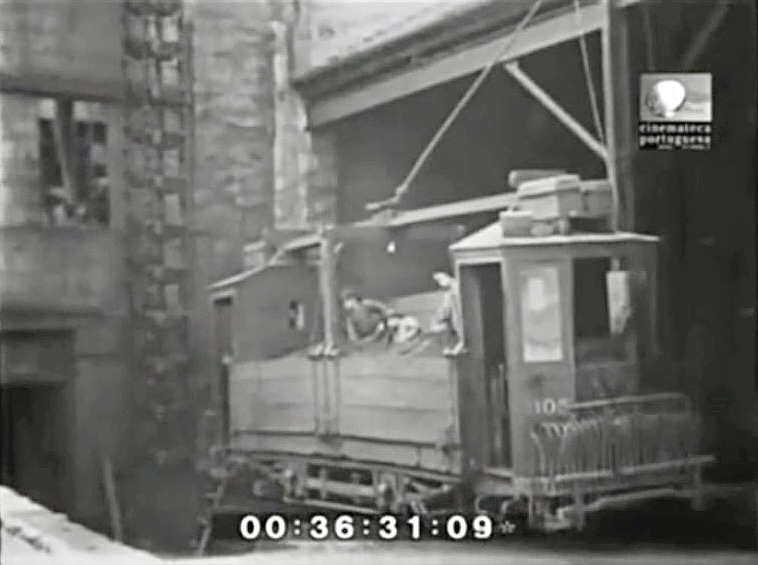
In 1910 Alliança made also six electric zorras (open freight cars) and four more were built by A Constructora, another local firm. In 1913 Alliança made twelve more electric zorras. They all had Brill 21E trucks and a loading capacity of 6 t. The six zorras of Alliança from 1910 had motors of Siemens, all others had General Electric GE80 motors. The Alliança zorras had complete open platforms and a steel arch for the trolley pole. The Constructora zorras had the trolley pole mounted on a wooden structure and closed platforms. In later years the workshops built more zorras of the Alliança type, most as replacements for other zorras and likely with reuse of the trucks, motors and other electric equipment. Later the Constructora zorras disappeared and the Alliança type zorras got closed platforms.
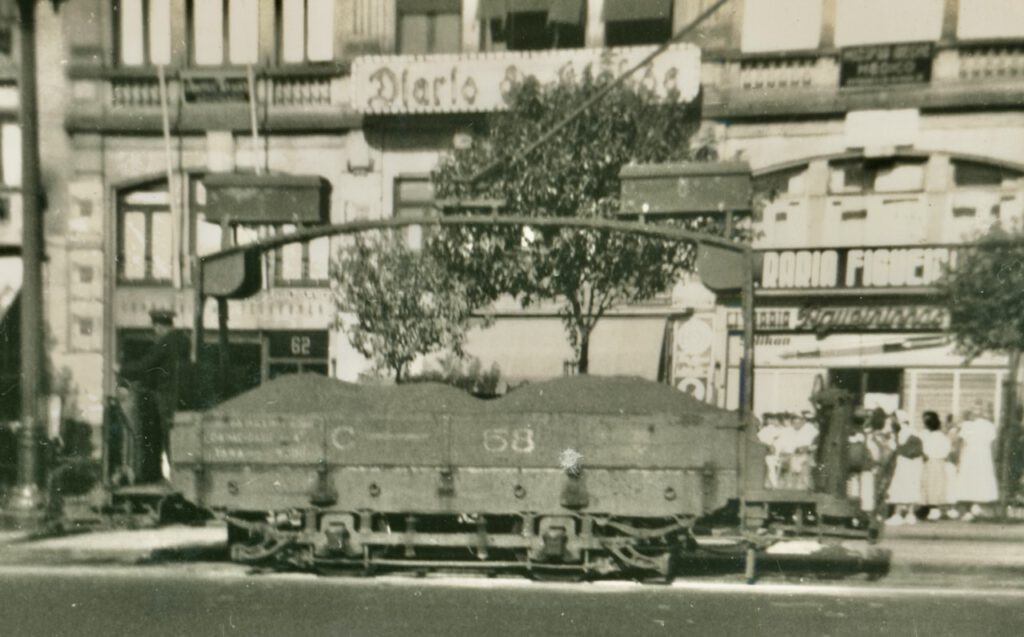
Many of these zorras were used for transport of coal, not only to the Massarelos power plant, but also to other companies using coal from the São Pedro da Cova mines. The STCP still had 26 zorras. Most were withdrawn after closure of the Massarelos power plant, but some were retained as works car. The zorras 58 and 66 belong to the museum collection, zorra no.77 is still available as works car
For the steam engines of the generators of the old small Arrábida plant that during the first decades powered the electric trams, good quality coal from abroad was used. But the boilers of the new, large Massarelos plant were designed to burn the low quality coal from the mines in São Pedro da Cova. This caused that the CCFP became the most important customer of the Minas de São Pedro da Cova.
From one mine shaft the coal was transported by a rope-way to the coal distribution of Monte Aventino and from there by zorras to Massarelos. This rope-way, in use from 1916 until 1970 and scrapped in 1972/3, was also the mode of transport for the coal to the Rio Tinto railway station. The CCFP made a freight branch from Rua Costa Cabral to the Monte Aventino coal depot. From 1917 another shaft of the mine had a connection with the tram network and the coal was directly brought by tram from this mine shaft to its destination.
In 1933 almost 44.400 metric tons of coal was used by the Massarelos plant. With a load of 6 tons this means about 7400 zorra trips from São Pedro da Cova or Monte Aventino to Massarelos, or on average just over 20 trips each day. As the coal of São Pedro da Cova was of poor quality, about eight zorras must have left Massarelos each day for removal of the ashes to dump sites.
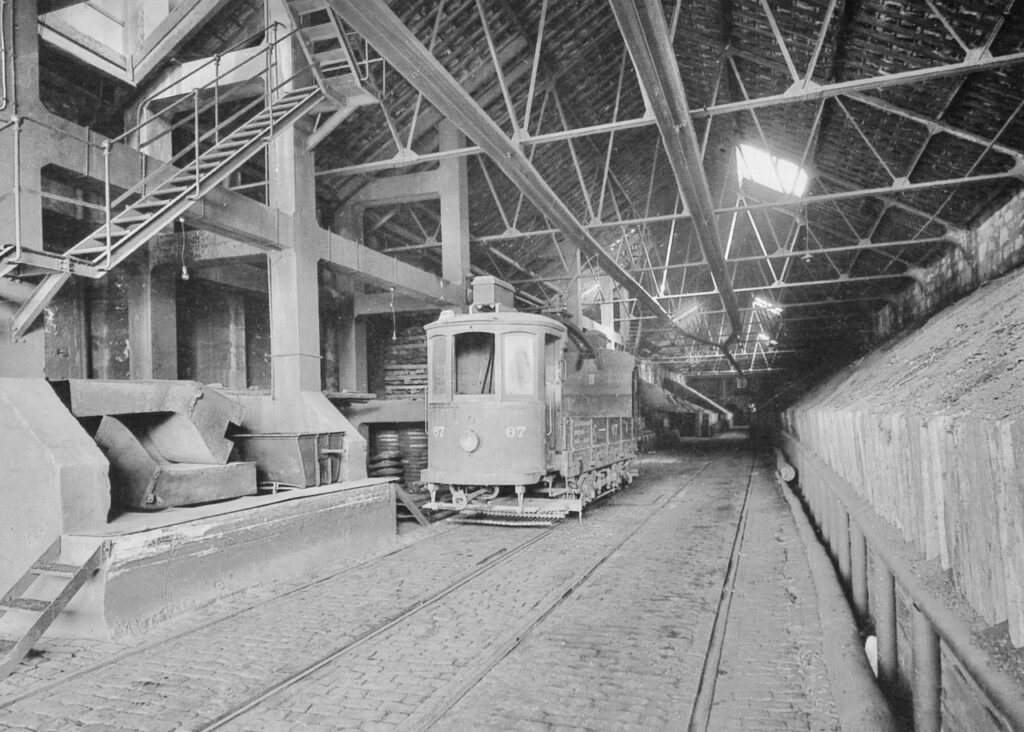
The CCFP wasn’t the only customer of coal from the São Pedro da Cova mines. Another large consumer was the Fábrica da Gaz at the river side. Here was already since 1904 a connection with the tram network. In 1919 about 70 to 80 tons of coal arrived in the gas factory on a daily basis. This were 12 to 13 zorras with coal.
Coal was also transported by tram to several other customers like the textile factory G & G Graham & Companhia on Avenida da Boavista on the corner with Rua Azevedo Coutinho. This branch was made in 1912 and had several branches on the site itself. It still existed in 1946.
Coal merchants like Delfim da Silva in Rio Tinto, Manoel de Sousa Matos in Sta.Eulália and the Empresa de Combustiveis, Lda. in Rua de Agramonte had sidings for freight trams. From Campo 24 de Agosto to Rua Santos Pouzada existed a side line for unloading coal and other merchandise.
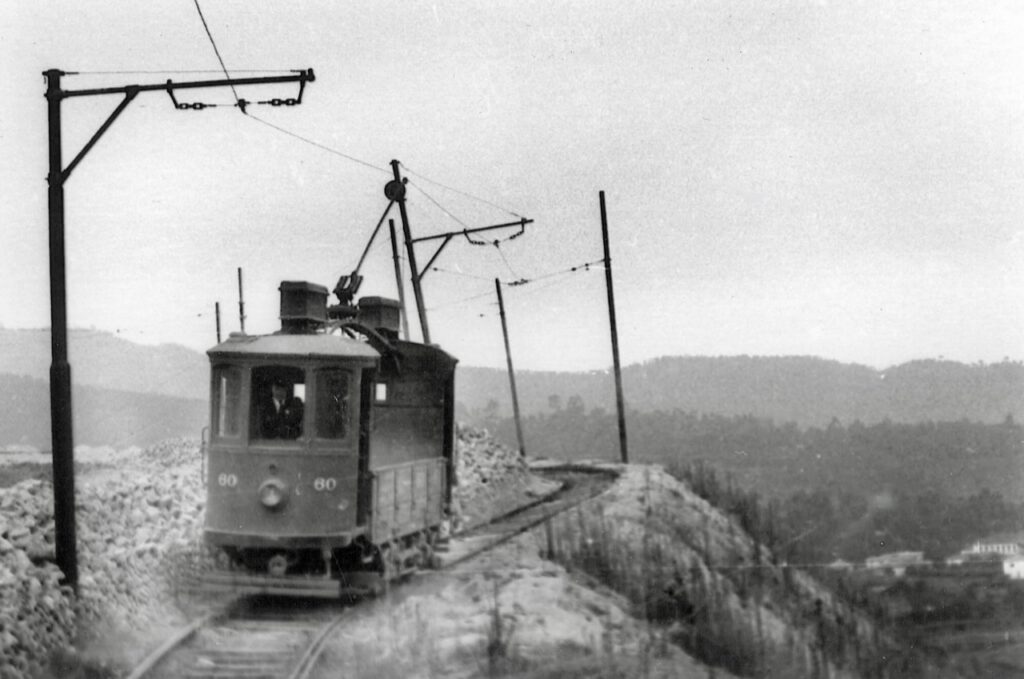
It wasn’t only coal that was transported by tram. Wine, wheat, fish, furniture, construction materials, etc. were also reported as transported. In short: everything.
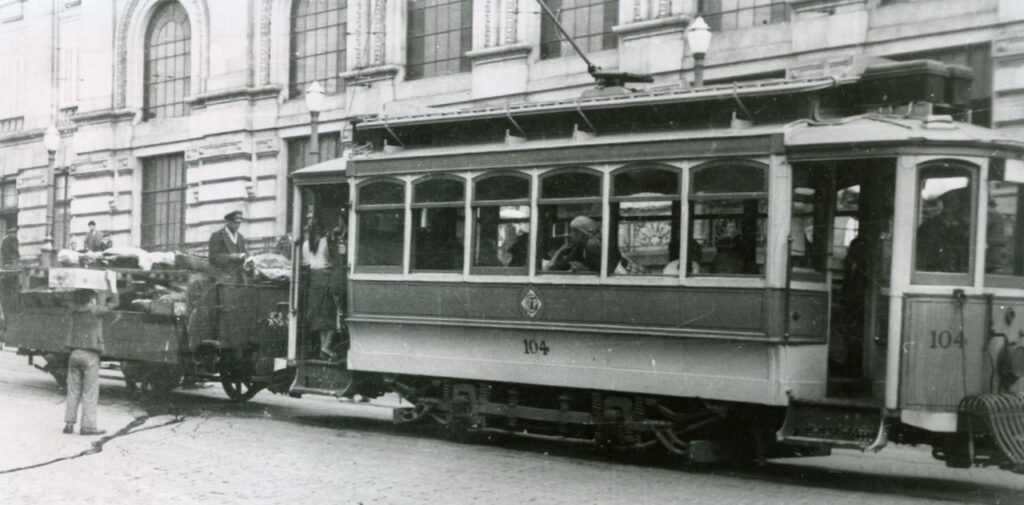
Sidings and even some longer lines were constructed for freight transport. Especially in Matosinhos with its fast developing industry were multiple sidings. Known are:
- Real Companhia de Vinicola do Norte de Portugal (later Vinicola: Vinicola Portuguesa Menéres & Cª). This line existed since 1898 and was lifted in 1941.
- Fabrica de Conservas. This siding existed since 1899. It’s unknown when it was lifted, but still existed in 1929.
- Fabrica de Brandão Gomes & Ca. It’s unknown when this branch was installed and lifted, but it seems that the original connection was with line 5 in Rua Roberto Ivens. Tramline 5 was removed from Rua Roberto Ivens in 1930 and it looks that from that moment the Brandão factory was connected to the branch of the Fabrica de Conservas and with that with line 1 in Rua Brito Capelo.
- Armazens Bento José Pereira da Cunha. This siding existed since 1899, it’s unknown when it was lifted.
- Empresa Concreto Lda.
There were also connections with the Leixões harbour. A freight line existed beyond the terminus at Castelo da Leça to the Northern mole. In Matosinhos a freight line branched off the tramline in Rua Brito Capelo via the Avenida da República, the Avenida de Serpa Pinto and the Rua de São Sebastião to the Praia de Peixe (Fish beach). From the Avenida de Serpa Pinto another freight branch went via the Rua Godinho to the Southern mole. In 1935 the route via Avenida Serpa Pinto was replaced by a direct route from Rua Brito Capelo via Rua Godinho to the Porto de Pesca (Fish harbour). By this time the landing of fish on the Praia de Peixe had likely ended.
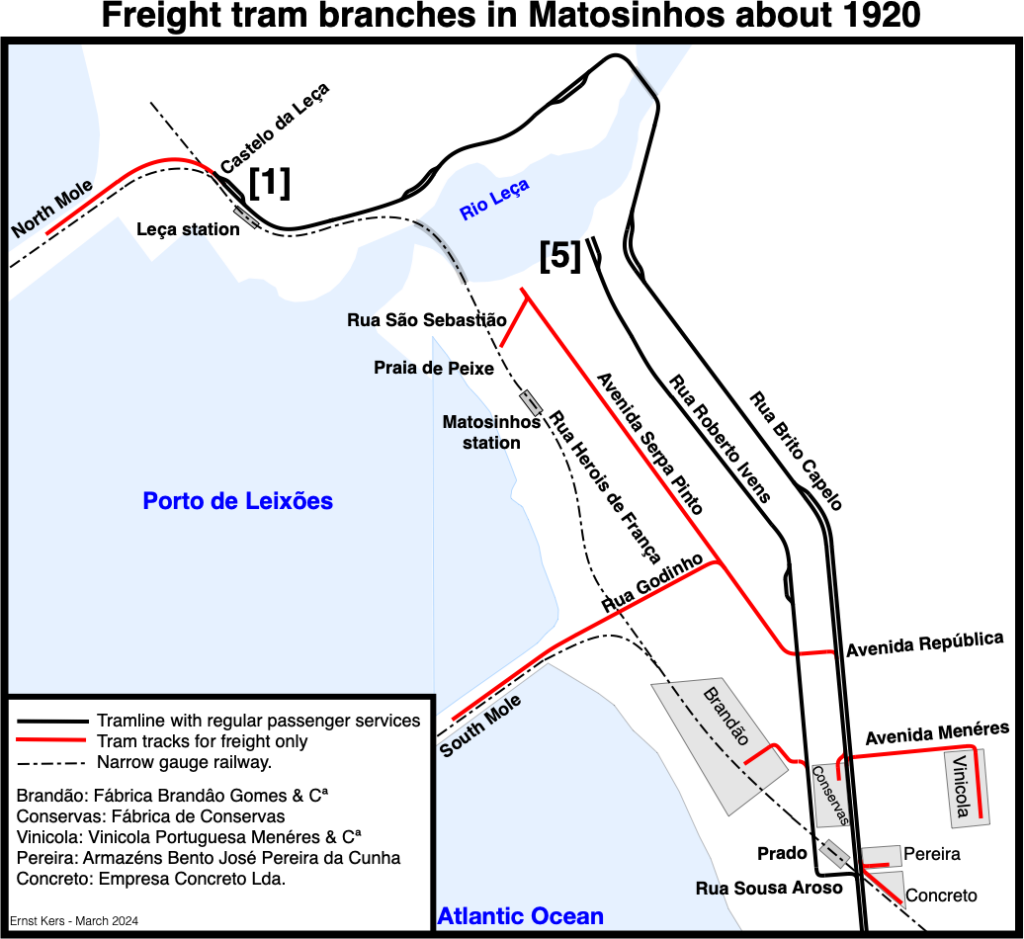
Also in Porto and VN de Gaia were factories with freight connections. Besides the already mentioned gas factory and Graham, factories known (likely there were more) to have had sidings for freight transport by tram were
- The yarn factory of Coats & Clark in VN de Gaia, a 700 m long line from Sto.Ovídio. This line existed since 1908 and was lifted in 1939.
- Fabrica de Moagem do Corpo Santo in Massarelos near the bottom of Rua da Restauração. This branch line existed already in 1910, but it’s unknown when it was lifted.
- CUFP – Companhia União Fabril Portuense das Fábricas de Cerveja e Bebidas Refrigerantes in Rua da Piedade. The beer brewery on this site was opened in 1904. The branch into it was installed in 1910. It’s unknown when it was removed, but likely before 1934, perhaps in 1931 when the own energy production was ended.
- Fabrica Portuguesa da Refinação in Rua São Dinis, a 300 m long line from Rua Antero Quental through Travessa Formosa – now Rua Cap.Pombeiro. It’s unknown when this branch was lifted, but it existed in 1911.
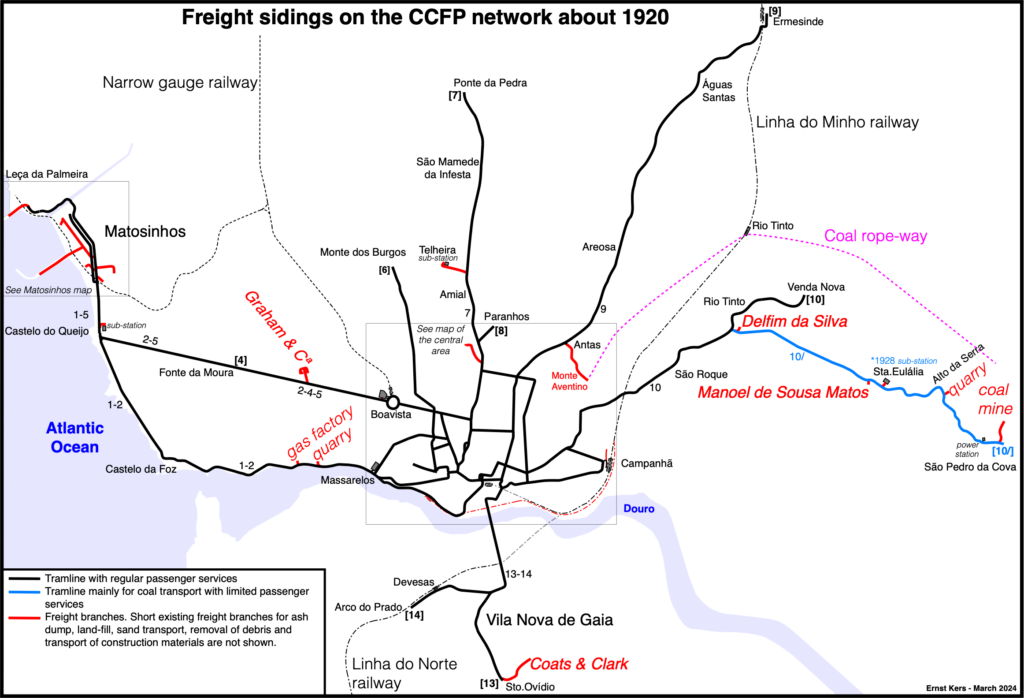
Of course there were also connections with the harbour facilities along the Douro (Alfândega, Cais da Paixão) and with the railway stations of Campanhã, São Bento (in Rua da Madeira) and Boavista. Both the Mercado do Bolhão and the Mercado do Peixe had sidings in both the mule tram period and later for electric trams.
The quarries at Arrábida and Alto da Serra (Fanzeres) also had sidings, the latter apparently later used for ash dump.
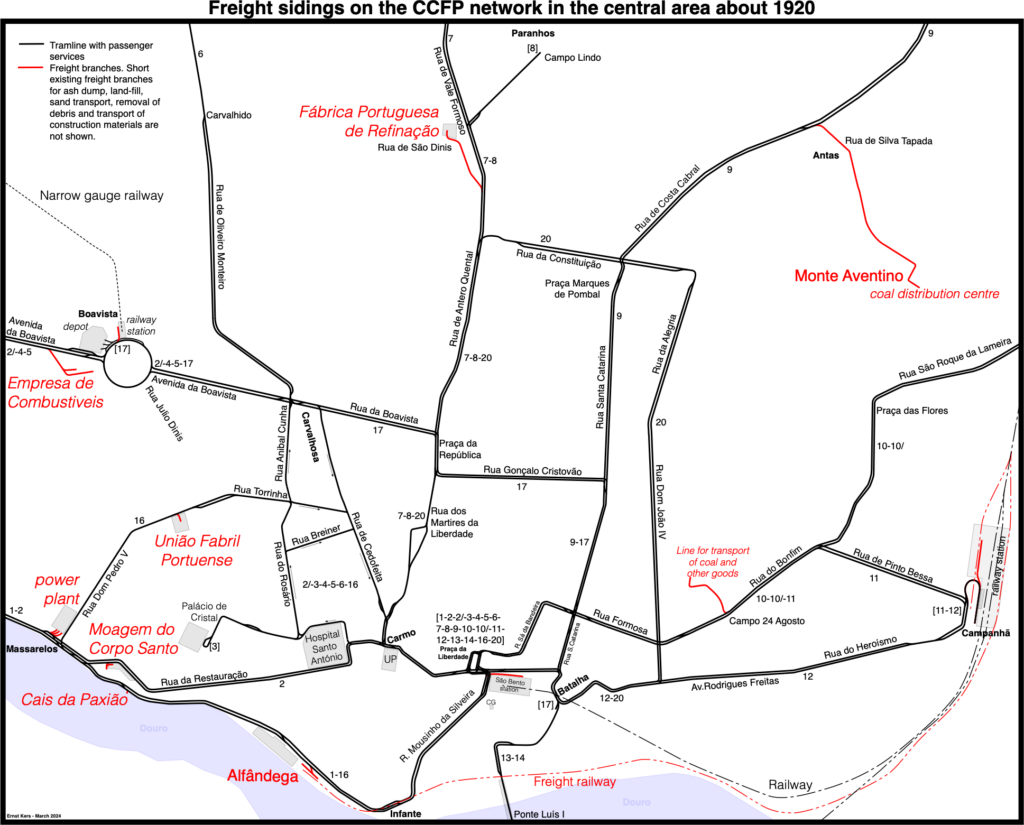
Temporary transports
Except for all these more permanent sidings, there were many temporary sidings for sand (A Cantareira, Castelo da Foz, Castelo do Queijo), debris and construction materials (Rua do Laranjal for opening and construction of the Avenida dos Aliados area, Rua Barão de Nova Cintra a 478 m long line for the Quinta das Oliveras of the SMAS, Rua dos Bragas for construction of the Faculdade de Engenharia, and for the construction of Avenida Gomes da Costa and Rua Julio Dinis). Other temporary lines were for landfill with the ash from the Massarelos plant: Rua do Padrão – Rua de Gondarém, Rua Julio Dinis at the Boavista end and near Rua da Piedade, Rua Dom Pedro V, Castelo do Queijo. Again, likely there were more temporary sidings, but they didn’t exist all at the same time.
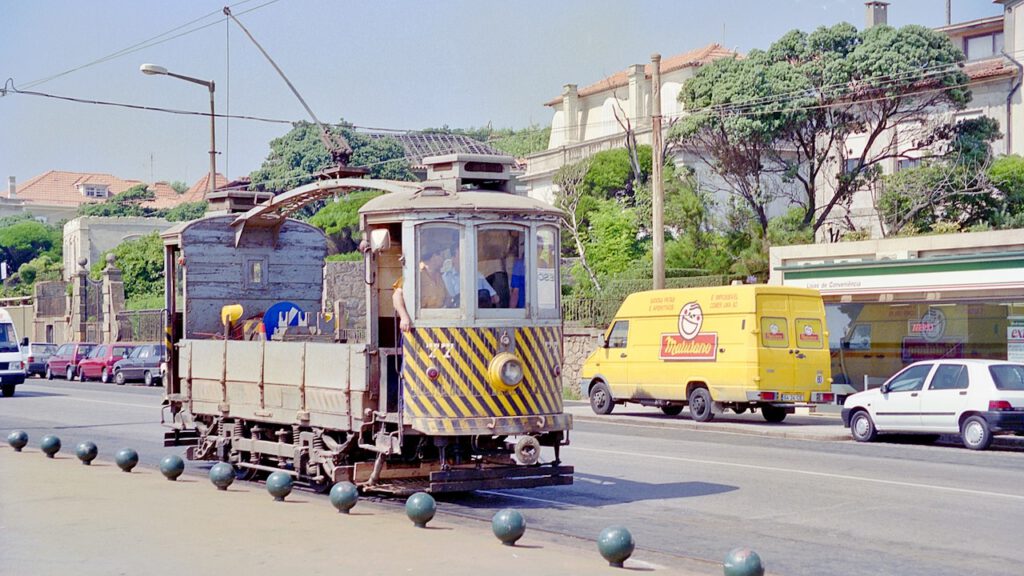
The End
During the 1920’s and 1930’s the commercial freight transport was almost completely lost to the competing motor lorries. The coal transport was ended with the closure of the Massarelos power plant in the 1950’s. The fish transport from Leixões likely ended in the early 1960’s, although until the closure of the tram route to Matosinhos in 1993, fish wives used the trams in the morning to go to the city centre with their fragrant merchandise on the rear platform.
Several zorras and one vagão survived as works cars.
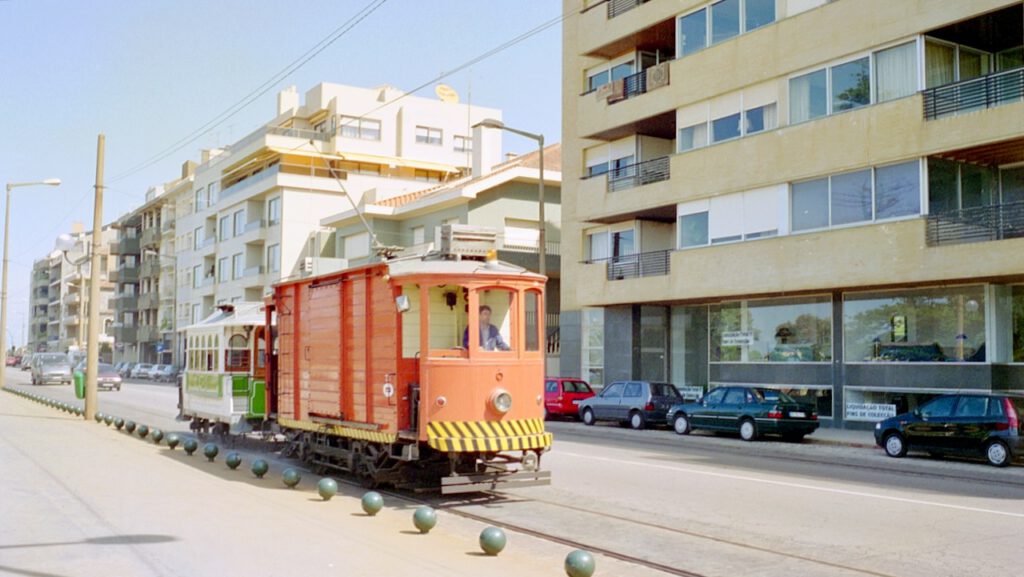
Sources
Guido de Monterey: O Porto, Origem, Evolução e Transportes, 2nd edition published in 1972.
Manuel Castro Pereira: Os Velhos Eléctricos do Porto, published in 1995.
John Price: The Tramways of Portugal, 1st edition 1964, 2nd edition 1972, 3rd edition 1883, 4th edition 1985 (3rd & 4th editions together with Brian King) Published by the LRTA.
Own research in the CCFP/STCP archives stored in the Arquivo Distrital do Porto, Rua das Taipas 90 – Porto.

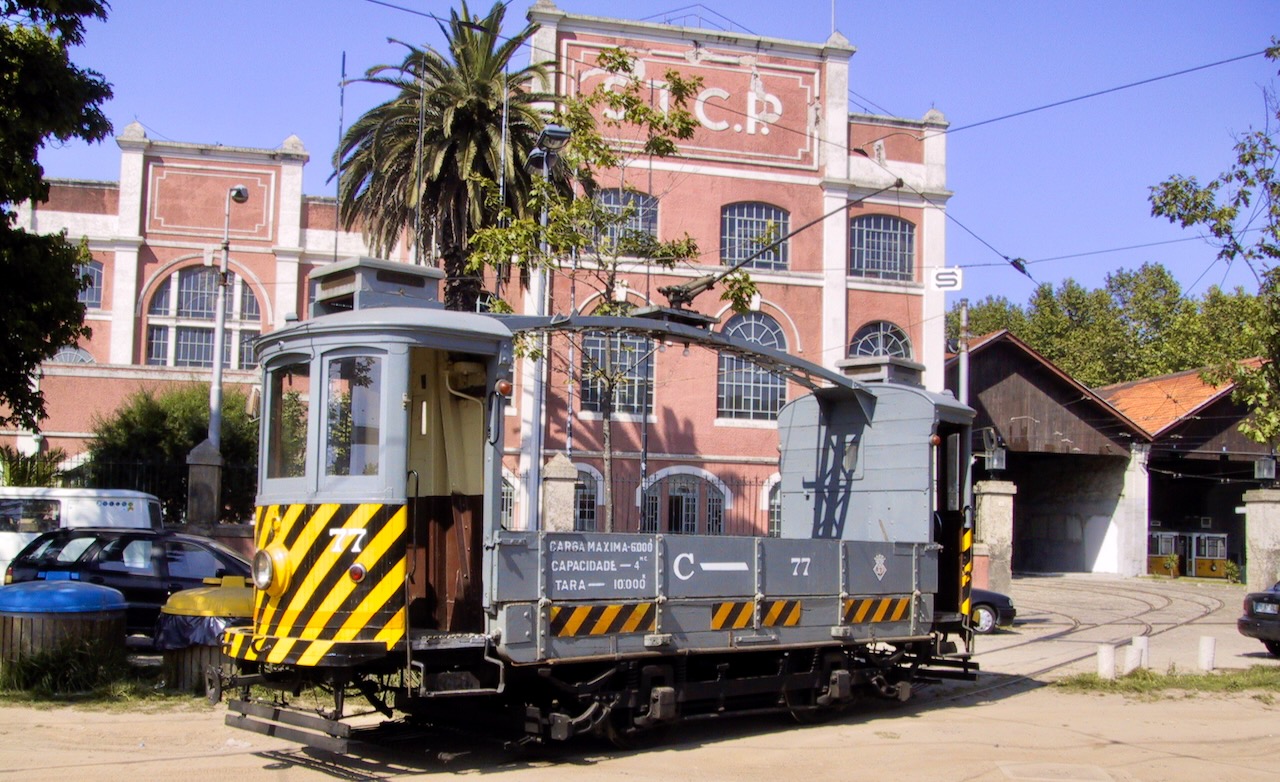
Leave a Reply